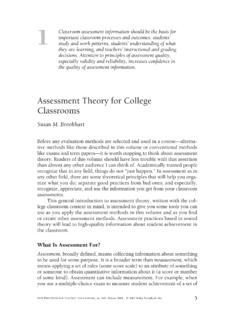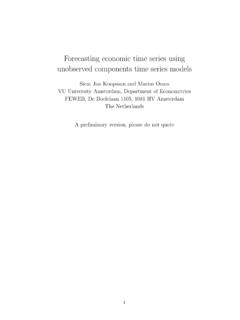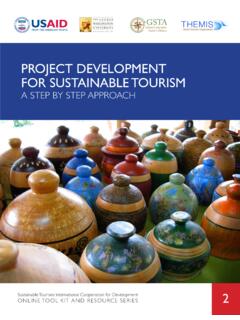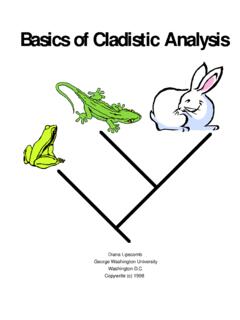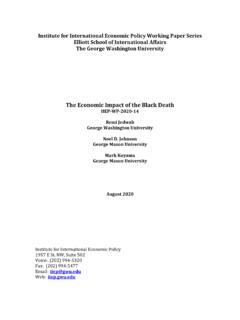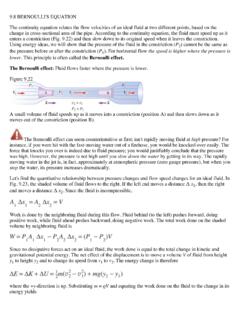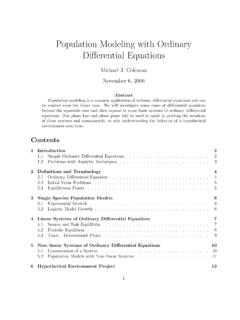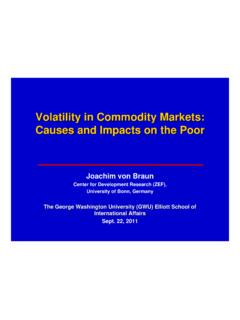Transcription of U.S. Population Projections: 2012 to 2060
1 Economics and Statistics CENSUS Department of Population Projections: 2012 to 2060 Presentation for the FFC/GW Brown Bag Seminar Series on ForecastingWashington, DCFebruary 7, 2013 Jennifer M. OrtmanPopulation DivisionEconomics and Statistics CENSUS Department of Commerce2012 National Projections First series based on the 2010 Census Projections of the Population by age, sex, race, and Hispanic origin Covers the period from 2012 to 20602 Economics and Statistics CENSUS Department of CommerceOverview Methodology and assumptions Mortality Fertility Net International Migration Highlights from the results3 Economics and Statistics CENSUS Department of CommerceMaking Population ProjectionsStarting PopulationBirthsandImmigrantsDeathsandEm igrantsFuture Population4 Economics and Statistics CENSUS Department of CommerceMortality Projections One series of mortality projections Three race and Hispanic origin groups Non-Hispanic White and Asian or Pacific Islander (API)
2 Non-Hispanic Black and American Indian or Alaska Native (AIAN) Hispanic 5 Note: The superseded Asian and Pacific Islander combined category is used due to the lack of historical data for the current categories of: (1) Asian and (2) Native Hawaiian and Other Pacific and Statistics CENSUS Department of CommerceMortality projection Methodology Life expectancy at birth is projected for each group to 2060 Hispanic life expectancy is projected to converge to the rate projected for the non-Hispanic White and API Population in 2035 Use Coale-Demeny West model life table to convert life expectancy projections to age-specific mortality rates6 Economics and Statistics CENSUS Department of Commerce76065707580859019891999200920192 029203920492059 Male Non HispanicWhite and APIMale Non HispanicBlack and AIANMale HispanicFemale Non HispanicWhite and APIF emale Non HispanicBlack and AIANF emale HispanicLife Expectancy at Birth by Sex, Race, and Hispanic Origin.
3 1989 to 2060 Non Hispanic White and APINon Hispanic Black and AIAN HispanicNon Hispanic White and APINon Hispanic Black and AIAN Expectancy at BirthYearEconomics and Statistics CENSUS Department of CommerceFertility Projections One series of fertility projections Rates for women aged 10 to 54 years Five race and Hispanic origin groups Non-Hispanic White Black American Indian or Alaska Native (AIAN) Asian or Pacific Islander (API) Hispanic8 Economics and Statistics CENSUS Department of CommerceFertility projection Methodology Average the age-specific fertility rates (ASFR) of non-Hispanic White females for 1989-2009 Assume the ASFRs of all five groups will converge to the average of the ASFRs for the non-Hispanic White group in 21009 Economics and Statistics CENSUS Department of Hispanic WhiteNon Hispanic BlackNon Hispanic AIANNon Hispanic APIH ispanicTotal Fertility Rates by Race and Hispanic Origin.
4 1989 to 2060 Year TotalNon Hispanic WhiteNon Hispanic BlackNon Hispanic AIANNon Hispanic API Hispanic2009 Fertility RateEconomics and Statistics CENSUS Department of CommerceNet International Migration Projections Foreign-born immigration (+) Foreign-born emigration (-) Net native-born migration (+)11 Economics and Statistics CENSUS Department of CommerceForeign-Born Immigration Projections Projected as a rate of emigration from sending countries Rates calculated for years 1980-2010 Rates are projected to move toward an ultimate rate12 Emigration Rate = Immigrants to United StatesSending Country PopulationEconomics and Statistics CENSUS Department of 2015 2020 2025 2030 2035 2040 2045 2050 2055 2060 TotalEurope, Central Asia,and the Middle EastAsia and Pacific IslandsNon Spanish Caribbean andSub Saharan AfricaSpanish Caribbean andLatin AmericaProjected Rates of Emigration from Sending Countries to the United States.
5 2012 to 2060(Migrants per 1,000 Population )Economics and Statistics CENSUS Department of CommerceCalculating Projected Foreign-Born Immigrants Projected immigrants to the United States were calculated for each year by multiplying the projected emigration rate from sending countries by the projected Population within each ImmigrantsProjected Emigration RateProjected SendingPopulation=*Economics and Statistics CENSUS Department of CommerceForeign-Born Emigration Projections Rates of emigration from the United States are estimated using a residual method and data from Census 2000 and the 2010 American Community Survey (ACS) The rates were produced and applied by age, sex, Hispanic origin, and arrival cohort Immigrants who arrived in the past 0-9 years Immigrants who arrived in the past 10-19 years Immigrants who arrived 20 or more years ago15 Economics and Statistics CENSUS Department of CommerceCalculating Projected Foreign-Born Emigrants Foreign-born emigration from the United States was projected by applying the emigration rates to the foreign-born Population The same set of rates, by age, sex, Hispanic origin, and arrival cohort, were used for all projected years16 Economics and Statistics CENSUS Department of CommerceNet Native-Born Migration Projections Comprised of migration of the native-born Population .
6 Including migration from Puerto Rico to the United States Current estimates of net native-born migration are held constant in the projected years17 Economics and Statistics CENSUS Department of Commerce187259091,1401,1741,2041,2152012 20202030204020502060 Net International Migration: 2012 to 2060(In thousands)Economics and Statistics CENSUS Department of HispanicWhiteNon HispanicBlackNon HispanicAsianNon HispanicOther RacesHispanic20122060 Net International Migrants by Race and Hispanic Origin: 2012 and 2060(Percent of total net international migrants)Other races includes American Indian or Alaska Native, Native Hawaiian or Other Pacific Islander, and Two or More and Statistics CENSUS Department of CommerceMain FindingsThe Population is projected to: Grow more slowly Continue aging Become more diverse20 Economics and Statistics CENSUS Department of Commerce21 Red columns represent Population estimates for 1990 States Population : 1990 to 2060 The Population is projected to increase from 314 million in 2012 to 420 million in 2060, reaching 400 million in (in millions)Economics and Statistics CENSUS Department of 2016 2020 2024 2028 2032 2036 2040 2044 2048 2052 2056 2060 Annual Percent Change in Total Population : 2012 to 2060 Economics and Statistics CENSUS Department of Commerce234,2102,5227254,9304,0391,215 BirthsDeathsNet International Migration20122060 Births, Deaths, and Net International Migration.
7 2012 and 2060(Numbers in thousands)Economics and Statistics CENSUS Department of Commerce2402004006008001,0001,2001,4001, 6001,8002012 2016 2020 2024 2028 2032 2036 2040 2044 2048 2052 2056 2060 Natural IncreaseNet International MigrationNatural Increase (Births Deaths) and Net International Migration: 2012 to 2060 Net international migration is projected to overtake natural increase as the primary driver of Population growth in (in thousands)Economics and Statistics CENSUS Department of Commerce25321012305101520253035404550556 065707580859095100+ Population (in millions)MalesFemalesPopulation by Age and Sex: 2012 Baby BoomersAge(years)Economics and Statistics CENSUS Department of Commerce26321012305101520253035404550556 065707580859095100+ Population (in millions)MalesFemalesPopulation by Age and Sex: 2035 Baby BoomersAge(years)Economics and Statistics CENSUS Department of Commerce27321012305101520253035404550556 065707580859095100+ Population (in millions)MalesFemalesPopulation by Age and Sex: 2060 Age(years)Baby BoomersEconomics and Statistics CENSUS Department of Commerce28321012305101520253035404550556 065707580859095100+ Population (in millions)20122060 MalesFemalesPopulation by Age and Sex: 2012 and 20602012 Population = 314 Million2060 Population = 420 MillionAge(years)Economics and Statistics CENSUS Department of Commerce29 Dashed lines represent Population estimates for 1990 Under 18 years 65 years and overPopulation Under 18 Years and 65 Years and Over.
8 1990 to 2060 Population (in millions)The Population 65 years and over is projected to become larger than the Population under 18 years in and Statistics CENSUS Department of Commerce30246314215722 Under 18 years18 to 64 years65 years and over20122060 Distribution of Population by Age: 2012 and 2060(Percent of total Population )Economics and Statistics CENSUS Department of Commerce31424138383938373720202128353736 3919902000201020202030204020502060 Youth DependencyOld Age DependencyTotal dependency = (( Population under age 18 + Population aged 65 years and over) / ( Population aged 18 to 64 years)) * 100. Old age dependency = ( Population aged 65 years and over / Population aged 18 to 64 years) * 100. Youth dependency = ( Population under age 18 / Population aged 18 to 64 years) * 100. Dependency Ratios for the United States: 1990 to 20606266757574766159 Economics and Statistics CENSUS Department of orMore RacesNon HispanicWhite AloneHispanic(of any race)20122060 Population by Race and Hispanic Origin: 2012 and 2060(Percent of total Population )AIAN=American Indian and Alaska Native.
9 NHPI=Native Hawaiian and Other Pacific IslanderEconomics and Statistics CENSUS Department of Commerce3301020304050607080901002012 2016 2020 2024 2028 2032 2036 2040 2044 2048 2052 2056 2060 Total Population Population under 18 yearsProjections of the Percent Minority: 2012 to 2060 The minority Population is projected to become the numerical majority of the Population under 18 years in of total populationThe minority Population is projected to become the numerical majority of the total Population in and Statistics CENSUS Department of Commerce34373932293529194227414239384238 254734 TotalWhitealoneBlackaloneAIAN aloneAsianaloneNHPI aloneTwo orMore RacesNon HispanicWhite aloneHispanic(of any race)20122060 Median Age by Race and Hispanic Origin: 2012 and 2060 AIAN=American Indian and Alaska Native; NHPI=Native Hawaiian and Other Pacific IslanderEconomics and Statistics CENSUS Department of CommerceMore InformationCensus Bureau Projections Website: Information:Jennifer
